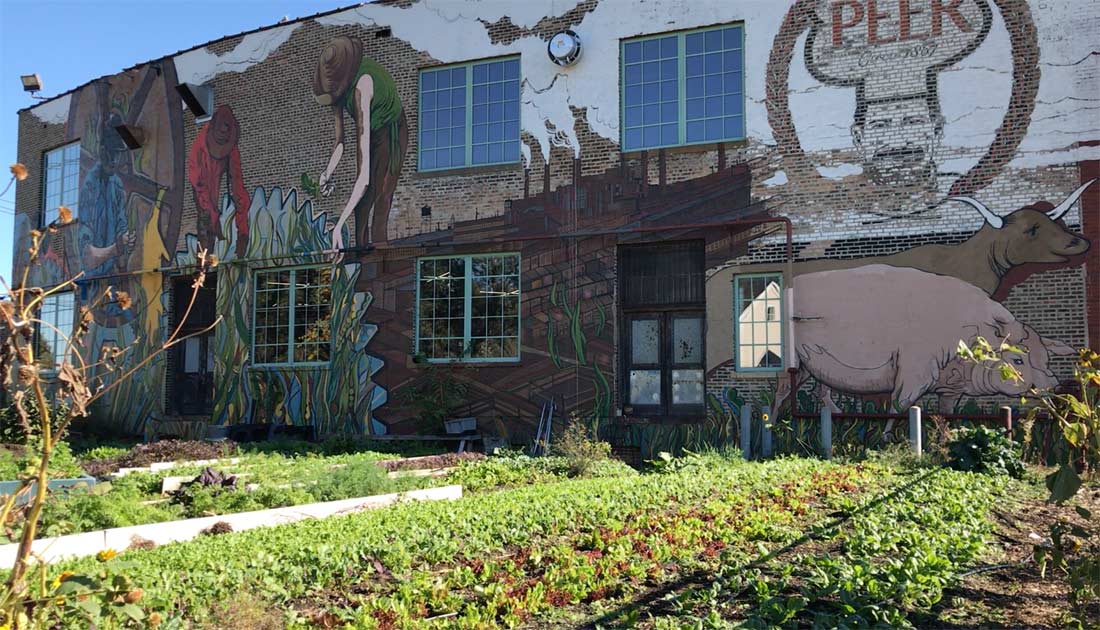By Yu-Ning Aileen Chuang
Before you trash the remnants of that Thanksgiving turkey or ram the last bits of stuffing into the garbage disposal, try thinking about how much food is wasted in the U.S. every day.
The U.S. throws away 30 percent of edible food annually, an equivalent of $161 billion worth of produce, according to the United Nations Environment Program (UNEP). The amount of U.S food wasted escalates to 50 percent when the produce thrown away by retailers is factored in, according to a recent Guardian report. UNEP data indicates that all this waste has a negative impact on the environment, the economy and society as a whole
But a collaborative community of Chicagoans believe they have a solution for our wasteful ways. They call it The Plant, a facility that takes an environment-friendly mindset to reusing food that would otherwise go to waste and increasing efficiency in the city with innovative ideas.
The Plant is a four-level building (including a basement) in the Back of the Yards neighborhood on the Southwest Side that houses a dozen food businesses, mostly small start-ups. John Edel, the owner of the building, is the founder of a social enterprise that focuses on sustainable urban industrial development named Bubbly Dynamics LLC.
The mission of Plant Chicago, a non-profit organization founded by Edel in 2011, is to develop “circular economies” starting within The Plant, but with designs to expand beyond Chicago. The principle is based on the notion that the byproducts generated by one producer can be taken fully advantage of by another. And that also links to the facility’s other aspiration of being energy efficient.
Energy efficiency exists when “that grain does not have to move very far in order to get a new life,” said Jonathan Pereira, Plant Chicago’s executive director, adding that the more materials and nutrients that never have to leave the building, the more energy is saved.
The ethos of sustainability is obvious from the moment you enter The Plant. Water-filled tubes of growing algae are mounted to the windowsills. Companies in the building work together to make a year-round farmers market happen. The farmers market is part of Plant Chicago’s public outreach, which includes educational programs and tours designed to encourage consumers to think deeper about shop smarter – with energy efficiency and conservation in mind.
The goal of the operators of The Plant is to spread the gospel of sustainability, Pereira said.
“There’s a culture here where everyone is thinking about ‘oh, do I really need this product? Maybe I shouldn’t be using polystyrene; instead, looking for a fiber-based product…’,” he added.
The Plant is operated like a food manufacturing space as well as a laboratory to create a closed-loop system in which the waste from one part of the building serves as the useful material for another. Ideally, this process would generate zero net waste.
“Once a business starts thinking about the waste it has, chances are there is someone else that can use it,” said Pereira.
Tenants at the facility exchange materials and waste regularly.
Whiner Beer Co., the occupant on the first floor, produces 2,000 pounds of spent grains each batch, Pereira said. The small business’s spent grains are used to grow mushrooms in the urban farm in the basement, and to make combustible biobricks that Plant Chicago has been experimenting on.
Coffee chaffs from Four Letter Word Coffee, one of the tenants on the second floor, are among the ingredients used to grow mushrooms and to produce a biobrick as well. The coffee roaster’s burlap sacks are used as a growing medium for the microgreens that are planted inside and outside of the building.
Another major waste product circulating in The Plant is water, Pereira said, adding that the mineral-rich output water from the ice company JustIce in the basement can be used as inputs for outdoor farms and other indoor options. Plant Chicago will be testing the water in 2017 and making recommendations for its use.
New techniques and projects initiated by Plant Chicago are under development to achieve the goal of a closed-loop system.
It plans to do a small-scale test of the biobricks in the Pleasant House Bakery, a tenant on the second floor, as a fuel source for its oven by the end of this year, said Eric Weber, Plant Chicago’s technology coordinator, in an email. He added that a larger scale experiment on the bricks will take place next year.
Other ongoing projects include one looking at the influence of carbon dioxide, which is generated by the brewing activities, on the algae production in the building. Plant Chicago installs several algae bioreactors in the building as another demonstration of its closed-loop system. The algae bioreactors are said to be a sustainable energy source that can produce biofuel and a variety of other products.
“Waste is just like sloppy planning, or inefficiency, or an inability to recognize an opportunity,” said Pereira.
He said every business should think about the money-making potential of their waste rather than merely thinking about their output as the things they don’t need.
Experiments at The Plant are a demonstration of what businesses can do to promote a healthier and more sustainable city.
“Yes, we only get to vote for a president once every four years, but we are literally voting every day with our money on what businesses we want to support, and what practices we want to support,” said Pereira. “When you find a business that you believe in, and you know it’s engaging in practices that advance the idea of circular economy, by all means, support that business.”
The story has been updated to reflect the role of Plant Chicago and the usage of the mineral-rich water.


